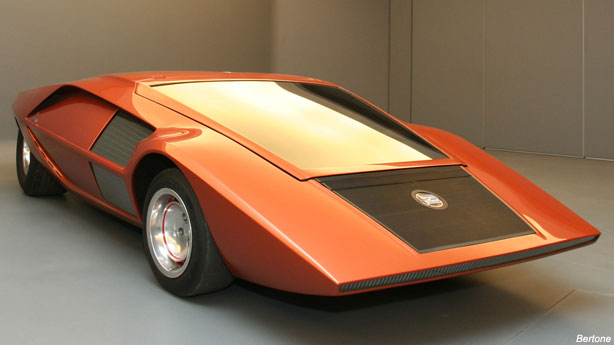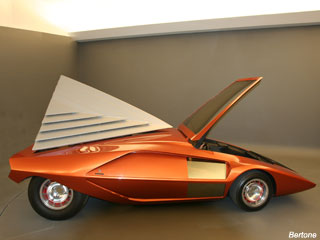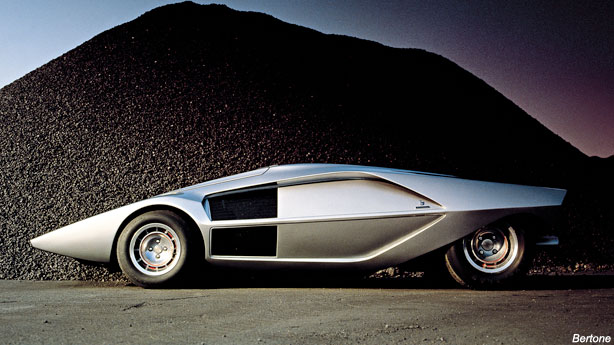
Plenty of concepts get resigned to the dustbin of history before they're even shown to the public at an auto show. A few rise above the clutter and make an appearance at another show or two before disappearing from view. Every once in a while a concept will actually define the design language of a company. But for a concept to point the entire auto industry in a specific direction? Well, that almost never happens. But it did with the Stratos Zero. Consider this sliver of a car, and if you don't see an entire decade of sports car design encapsulated in its wedge-shaped profile, you must not remember the '70s. Cars like the Fiat X1/9, TVR Tasmin, Triumph TR7, Ferrari 308 GT4, Lamborghini Countach, and Delorean DMC-12 all derived their "doorstop" look from the pioneering work of Bertone.
 First shown at the Turin auto show in 1970, the Stratos Zero was a mid-engined sports car built around a compact 1.6-liter, V4 Lancia engine. It was designed by the legendary Marcello Gandini, the same genius who did the Countach and the Lamborghini Miura. The Stratos Zero actually served as an initial prototype for the Lancia Stratos HF (the suffix standing for "High Fidelity"), the dominant rally car of its era and the first such vehicle to be purpose-built for that type of racing. But the Zero was far more radical than the ensuing production Stratos -- or any other production car, for that matter.
First shown at the Turin auto show in 1970, the Stratos Zero was a mid-engined sports car built around a compact 1.6-liter, V4 Lancia engine. It was designed by the legendary Marcello Gandini, the same genius who did the Countach and the Lamborghini Miura. The Stratos Zero actually served as an initial prototype for the Lancia Stratos HF (the suffix standing for "High Fidelity"), the dominant rally car of its era and the first such vehicle to be purpose-built for that type of racing. But the Zero was far more radical than the ensuing production Stratos -- or any other production car, for that matter.
Rather than employing doors, the entire windshield of the Zero hinged outwards to allow the driver and passenger to climb in. A triangular panel opened at the rear for access to the engine. Side windows were actually two glass panels that covered the entire area where the door would normally be. At just 33 inches tall and 141 inches long, the Zero was shorter than today's Mini Cooper and almost two feet lower to the ground.
For all its revolutionary appeal, the Stratos Zero was actually a further development on the wedge theme that Bertone had created for the Alfa Romeo Carabo two years earlier. But that was much more of a real car, while the Zero was in every way a futuristic fantasy. Perhaps that's why when Michael Jackson made "Moonwalker" in 1988, it featured the Stratos Zero. The King of Pop actually shape-shifted into the car. Nobody ever accused Jackson of being sane.
Alas, by the time Moonwalker exposed the Stratos Zero to a new generation of children, the design had become nothing more than a relic of history. That's because even as the Stratos Zero forecast the wedge, it couldn't presage the increasingly stringent safety regulations that would make building production cars like it all but impossible. As the '70s bled into the '80s, the wedge was abandoned by stylists across the world, in no small part due to the necessity of building cars that performed better in crash testing. Further safety regulations for pedestrian collisions developed in the European Union have all but ensured that cars will never again employ this angular theme with its sharply raked hood and tail.



Sign in to post
Please sign in to leave a comment.
Continue